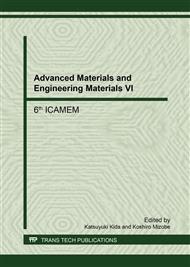[1]
Chen XB. Handbook of composites based on polymer. 1st ed. Beijing: Chemical Industry Press; (2004).
Google Scholar
[2]
Toldy A, Szolnoki B, Marosi Gy. Flame retardancy of fibre-reinforced epoxy resin composites for aerospace applications. Polym Degrad Stab. 96(2011): 371-376.
DOI: 10.1016/j.polymdegradstab.2010.03.021
Google Scholar
[3]
Xu Y, Hoa SV. Mechanical properties of carbon fiber reinforced epoxy/clay nanocomposites. Compo. Sci. Technol. 68(2008): 854-861.
DOI: 10.1016/j.compscitech.2007.08.013
Google Scholar
[4]
Liu WC, Varley RJ, Simon GP. Polymer. Understanding the decomposition and fire performance processes in phosphorus and nanomodified high performance epoxy resins and composites. Polymer. 48(2007): 2345-2354.
DOI: 10.1016/j.polymer.2007.02.022
Google Scholar
[5]
Jang J., Shin S. Toughness improvement of tetrafunctional epoxy resin by using hydr-olysed poly(ether imide). Polymer. 36(1995): 1199-1207.
DOI: 10.1016/0032-3861(95)93921-8
Google Scholar
[6]
Ragosta G., Abbate M., Musto P., Scarinzi G., Mascia L. Epoxy-silica particulate nanocomposites chemical interactions reinforcement and fracture toughness. Polymer. 46(2005): 10506-10516.
DOI: 10.1016/j.polymer.2005.08.028
Google Scholar
[7]
Chen P, Wang DZ. Epoxy resins and their applications. 1st ed. Beijing: Chemical Industry Press; 2004. p.159.
Google Scholar
[8]
Yu MM, Bai RC, Li AJ, Sun JL, Ren MS, Hu HF. A modification method for aromatic multifunctional epoxy resins. Chinese Patant. CN201210382441. 3.
Google Scholar
[9]
Liu XX, Yang XJ, Wang X, Lu LL. Effect of nanometer sized TiO2 on reactivity and thermla properties of modified BMI resins. Acta Materiae Compositae Sinica. 18(2001): 12-15.
Google Scholar
[10]
Park JW, Oh SC and Lee HP. A kinetic analysis of thermal degradation of polymers using a dynamic method. Polym Degrad Stab. 67(2000): 535-540.
Google Scholar
[11]
Barral L, Díez FJ, García-Garabal S, López J, Montero B, Montes R, Ramírez C, Rico M. Thermo-degradation kinetics of a hybrid inorganic-organic epoxy system. Eur Polym J. 41(2005): 1662-1666.
DOI: 10.1016/j.eurpolymj.2005.01.021
Google Scholar
[12]
Wang QF, Shi WF. Kinetics study of thermal decomposition of epoxy resins containing flame retardant components. Polym Degrad Stab. 91(2006): 1747-1754.
DOI: 10.1016/j.polymdegradstab.2005.11.018
Google Scholar


